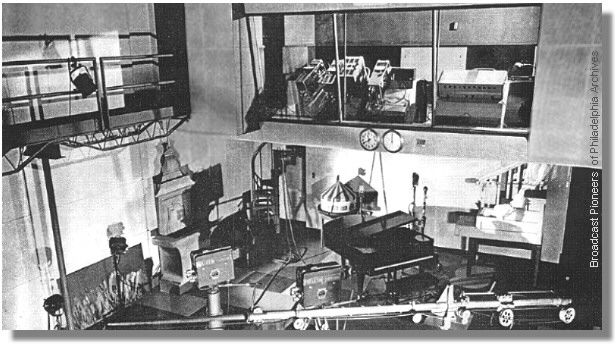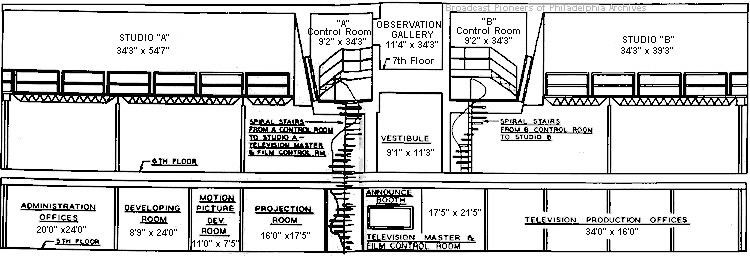
There are 2 photos and one sketch on this page. Please make sure you scroll all the way down so that you can see and read everything.

Control Room B
1948
Video control units shown here were in Control Room B. General arrangement of equipment was similar to that of Control Room A. Control Room B looked into Studio B.
On the left is Producer Paul Ritts (who also served as Director.) In the center is an unidentified technican. Paul was wearing headseats (not shown in picture) which allowed him to keep in touch with the floor manager (at that time called an "Assistant Producer") who cued the talent. The larger monitor (on left) showed what was being transmitted over the air. On the right were two camera monitors, showing what was being transmitted to the control room. Either shot could be placed on the air by throwing a switch.
Shown in the monitors was Amos Kirby, host of the WCAU-TV program "How Does Your Garden Grow" which aired Tuesday evenings (the show began on May 25, 1948) from 8:15 to 8:30 pm. Kirby was mainly known for his Sunday Bulletin column "The Farmer Comes to Town." The photo dates from before the show ever hit air. It was taken at a rehearsal session.

Studio B
1948
This was the view of Studio B from one of the catwalks which extended along the sides of both Studio A and Studio B. Look in the middle of the right side of this picture. That circular stairway provided quick access from the studio to the control room.

Floor Plan of WCAU-TV
1948
This was a view of the 5th, 6th and 7th floors of the WCAU Building at 1622 Chestnut Street in Center City. Note the spiral staircase which provided quick passage between floors.
The Studio B Control Room was located on the same level as Studio A's Control Room and the two control rooms were separated by a visitors gallery. The camera control units were located near the middle of the control room and adjacent to the large window separating Studio B from the control room, as in Studio A control. The master monitor was mounted to the left of the camera control units in a Field Carrying Case. All of the camera control units and master monitor were mounted on specially built wooden stands as in Studio A's control room. In 1948, the RCA TS-10A studio switcher was located to the left and behind the master monitor. The future plan was to raise the switcher and the producer's position so that the producer would be able to look down into the studios over the camera control units. Whether this was ever done, we don't know.
In 1948, to the left of the switcher was located the audio consolette, and to the left of the audio engineer's position, two turntables were placed within easy reach. To the right of the camera control units an RCA 721TS receiver was mounted and served as an on-the-air monitor. A Tele-talk unit was mounted on the studio switcher rack and provided communication between that point and TV control room, Studios A and X and the projection room. A talk-back microphone was located on the producer's right, as in Studio A control.
Power supplies for the camera control united were located at the far left side of the control room underneath the steps leading to the gallery. The power supplies for the master monitor, studio switcher and the stabilizing amplifier were rack mounted at the right rear of the control room.
Wire ducts in the floor housed all cables and wires as in Control Room A. Doors on either side of the control room led to the studio lighting bridge and a door on the right rear of the control room led to a spiral stairway into the studio. As in Studio A's control room, the producer, video and audio engineers had a full view of the studio as well as the picture monitors.
From the official archives of the Broadcast Pioneers of Philadelphia
Photos originally donated by Broadcast Pioneers member Allen Murphy
All Rights Reserved
The e-mail address of the Broadcast Pioneers of Philadelphia is pioneers@broadcastpioneers.com